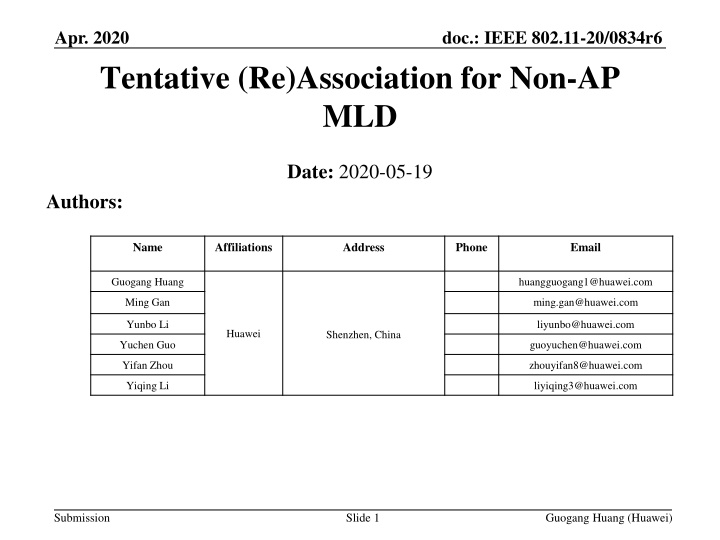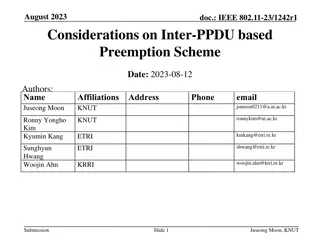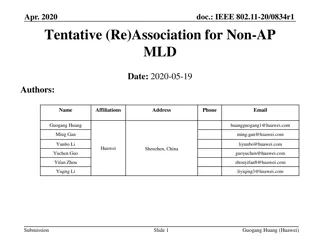IEEE 802.11-20/0834r6: Make Before Break Scheme Implementation
This document discusses the Make Before Break scheme to minimize data delivery interruptions during roaming for a single-radio STA. It addresses the challenges of interrupted data delivery during tentative association with a new AP on a different channel and proposes solutions to implement this scheme effectively under the MLD framework. Key topics covered include association operations, authentication processes, and necessary actions before data transfer in the IEEE 802.11 specification.
Download Presentation

Please find below an Image/Link to download the presentation.
The content on the website is provided AS IS for your information and personal use only. It may not be sold, licensed, or shared on other websites without obtaining consent from the author.If you encounter any issues during the download, it is possible that the publisher has removed the file from their server.
You are allowed to download the files provided on this website for personal or commercial use, subject to the condition that they are used lawfully. All files are the property of their respective owners.
The content on the website is provided AS IS for your information and personal use only. It may not be sold, licensed, or shared on other websites without obtaining consent from the author.
E N D
Presentation Transcript
doc.: IEEE 802.11-20/0834r6 Apr. 2020 Tentative (Re)Association for Non-AP MLD Date: 2020-05-19 Authors: Name Affiliations Address Phone Email Guogang Huang huangguogang1@huawei.com Ming Gan ming.gan@huawei.com Yunbo Li liyunbo@huawei.com Huawei Shenzhen, China Yuchen Guo guoyuchen@huawei.com Yifan Zhou zhouyifan8@huawei.com Yiqing Li liyiqing3@huawei.com Submission Slide 1 Guogang Huang (Huawei)
doc.: IEEE 802.11-20/0834r6 May 2020 Introduction For a STA with one single radio, the data delivery will be interrupted during a roaming until the re-association with a new AP is completely finished Contribution [1] first proposed the Make Before Break concept to reduce the gap in data delivery during a roaming in 2003 Exploit the power save mechanism to communicate to both old AP and new AP on the different channels Considering the fact of inter-frequency deployment and the limitation of only one single radio, the data delivery will be still interrupted during the tentative association with the new AP on a different channel This contribution will address how to implement the Make Before Break scheme under the MLD framework Submission Slide 2 Guogang Huang (Huawei)
doc.: IEEE 802.11-20/0834r6 May 2020 Recap-Association Operation STA AP AS Necessary Actions before data transfer 802.11 open system authentication Exchange Association Request/Response frames 802.1X authentication if needed Derived PMK 4-way handshake if needed Derived PTK and GTK Authentication 802.11 open system authentication Authentication Association Request Security parameter exchange: STA determines whether PSK or 802.1X authentication applies Sending DS- STA-NOTIFY. Primitive to DS ? Association Response (Optional) EAP-Start EAP Request/Identity EAP Response/Identity Radius-Access-Request 802.1X authentication, if needed ... ... (PMK) Radius-Access-Accept EAP -Success Key Message 1 Key Message 2 4-Way Handshake, if needed Key Message 3 Key Message 4 Data Transfer Submission Slide 3 Guogang Huang (Huawei)
doc.: IEEE 802.11-20/0834r6 May 2020 Recap-Association Operation 802.11 Spec-2016. At any given instant, a STA is associated with no more than one AP. This allows the DS to determine a unique answer to the question, Which AP is serving STA X? Once an association is completed, a STA can make full use of a DS (via the AP) to communicate. DS-STA-NOTIFY.request primitive Update STA-AP Mapping info When to send DS-STA-NOTIFY.request primitive to the DS is not clearly defined in the current Spec. The reason may be that it doesn t matter for the single-radio client The high probability is that DS-STA-NOTIFY.request is automatically sent after successful (Re)association Request/Response exchange with Status Code SUCCESS Submission Slide 4 Guogang Huang (Huawei)
doc.: IEEE 802.11-20/0834r6 May 2020 Recap-Fast BSS Transition AC/AS Maybe need to go to AC/AS to inquire PMKID info The data delivery is interrupted during this period. Submission Slide 5 Guogang Huang (Huawei)
doc.: IEEE 802.11-20/0834r6 May 2020 Recap-Make Before Break [1] Main Idea In order to minimize or eliminate any gap in data delivery while roaming, it is proposed to let a STA make a partial connection with a new AP without dropping the connection with the old AP. Then the STA can negotiate with the new AP to set up the correct conditions for data connectivity, while still using the old AP for data connectivity. Once the correct conditions are set up, the new AP will trigger DS-STA-NOTIFY.request primitive to update STA-AP mapping info. The STA can then break the connection with the old AP, and start using the new AP for data connectivity. Submission Slide 6 Guogang Huang (Huawei)
doc.: IEEE 802.11-20/0834r6 May 2020 Recap-Make Before Break (Cont.) Split necessary actions before data transfer into two parts Part-1 action. All necessary actions except of sending the DS-STA- NOTIFY.request primitive to the DS e.g. Authentication, Association Request/Response, 802.1 X authentication, 4-way handshake to generate PTK and GTK, even BA agreement setup Note that existing EAPOL security communications are, strictly speaking, between the STA and the AP; the AP proxies these messages to the DS using its own MAC address, rather than the MAC address of the STA. In other word, during this period, communication is only allowed between STA and AP, but not from STA to DS directly. Part-2 action. Sending the DS-STA-NOTIFY.request primitive to the DS Submission Slide 7 Guogang Huang (Huawei)
doc.: IEEE 802.11-20/0834r6 May 2020 Recap-Make Before Break (Cont.) Procedure of Make Before Break Step 0. STA enters Power Save with the old AP Step 1. STA sends a Tentative Association Request frame to the new AP. Step 2. Once the new AP responds to this request with a Tentative Association Response frame, the new AP and the STA would then be free to do Part-1 actions in order Step 3. STA sends a Complete Association Request frame to the new AP Step 4. In response, the new AP sends a Complete Association Response frame to the STA, and DS-STA-NOTIFY.request primitive to DS. At this point, the association is complete, and the data delivery can go through the new AP. Note that before sending the DS-STA-NOTIFY.request primitive to the DS, if the association with the new AP is failed, the STA can go back to the old AP Submission Slide 8 Guogang Huang (Huawei)
doc.: IEEE 802.11-20/0834r6 May 2020 Make Before Break under MLD Framework Phase 1. Prior roaming Non-AP MLD inform AP MLD 1 to disable Link 12 due to low RSSI. Then non- AP MLD will let STA 2 to do the multi-link tentative association with neighboring candidate AP MLD or AP Moving direction Submission Guogang Huang (Huawei)
doc.: IEEE 802.11-20/0834r6 May 2020 Make Before Break under MLD Framework Phase 2. During roaming STA 2 affiliated with non-AP MLD tries to do the tentative multi-link association with AP MLD 2 on CH2@2.4 GHz. In the Multi-link Re-association Request/Response frame, non-AP MLD will inform AP MLD 2 to disable link 21. The the following actions maybe included, e.g. 802.11 Authentication Request/Response frames exchange (Multi-link) Re-association Request/Response frames exchange ADDBA Request/Response exchange, even ADDTS Request/Response exchange to add a time-sensitive TS. Please see Annex-Resource Request Meanwhile, non-AP MLD still can deliver data traffic with AP MLD 1 through Link 11 Moving direction Submission Slide 10 Guogang Huang (Huawei)
doc.: IEEE 802.11-20/0834r6 May 2020 Make Before Break under MLD Framework Considering the following passed motion Motion. 802.11be defines a directional-based TID-to-link mapping mechanism among the setup links of a MLD. By default, after the multi-link setup, all TIDs are mapped to all setup links. The multi-link setup may include the TID-to-link mapping negotiation. BA agreement is set up before sending DS-STA- NOTIFY.request primitive to the DS It can reduce the delay of data delivery introduced by BA agreement negotiation after sending DS-STA-NOTIFY.request primitive to the DS This is very useful for roaming Submission Slide 11 Guogang Huang (Huawei)
doc.: IEEE 802.11-20/0834r6 May 2020 Make Before Break under MLD Framework Phase 3. Post roaming Step 1. Non-AP MLD sends a new frame to trigger AP MLD 2 to send the DS-STA-NOTIFY.request primitive to the DS. This will cause that all MSDUs belonged to non-AP MLD will be routed to AP MLD 2. Step 2. Then non-AP MLD is allowed to deliver data with AP MLD 2 only through link 22. STA 1 affiliated with non-AP MLD can switch to CH2@5 GHz. Step 3. When entering the coverage of AP 21 affiliated with AP MLD 2, non-AP MLD can inform AP MLD 2 to enable link 21. Then non-AP MLD is allowed to deliver data with AP MLD 2 through both Link 21 and Link 22 From the above roaming procedure, we can see that the data delivery with non-AP MLD is not interrupted. Moving direction Submission Slide 12 Guogang Huang (Huawei)
doc.: IEEE 802.11-20/0834r6 May 2020 Make Before Break under MLD Framework Extension 1 For the roaming scenario, assuming that Non-AP MLD having 3 links, it can disable two links and initiate tentative re-association with two neighboring AP MLDs simultaneously. Finally, the Non- AP MLD would have to complete the association with only one AP MLD by sending STA-AP Mapping Notify frame. Pros. Increase the success probability of roaming considering the roaming may be rejected by candidate AP MLD due to the specific admission control policy or some reason Submission Slide 13 Guogang Huang (Huawei)
doc.: IEEE 802.11-20/0834r6 May 2020 Make Before Break under MLD Framework Extension 2 Similarly, for the initial association scenario, assuming that Non- AP MLD having 3 links, it can initiate tentative association with three neighboring AP MLDs simultaneously. Finally, the Non-AP MLD would have to complete the association with only one AP MLD by sending STA-AP Mapping Notify frame Pros. Increase the success probability of association considering the association may be rejected by AP MLD due to the specific admission control policy or some reason To avoid performing 802.1X authentication with multiple AP MLDs, non-AP MLD maybe send a new defined frame to initiate the 802.1X authentication with only one selected AP MLD Submission Slide 14 Guogang Huang (Huawei)
doc.: IEEE 802.11-20/0834r6 May 2020 Related Signaling Indication Signaling of link status Option 1. Non-AP MLD needs to explicitly indicate the status of each non- transmitted link in the Association Request frame Disable. For the disable link, maybe further indicate the corresponding Reason Code, e.g. power save, low RSSI and unreachable, tentative association and so on. Enable. Option 2. use the TID-to-link mapping to implicitly indicate the status of each non- transmitted link in the Association Request frame Capability indication for tentative association Can be carried in Fast BSS Transition element , Mobility Domain element, RSNE or EHT Capabilities element Submission Slide 15 Guogang Huang (Huawei)
doc.: IEEE 802.11-20/0834r6 May 2020 Related Signaling Indication (Cont.) Signaling of tentative association In order to allow non-AP MLD simultaneously initiating tentative association with multiple AP MLDs, a frame needs to be defined to trigger AP MLD sending DS-STA- NOTIFY.request e.g. new announcement frame or uplink data frame or QoS Null frame To differentiate with the conventional association, a signaling indication for tentative association needs to be carried in the Association Request frame One method is to define a new element, named Tentative Association element, which includes the following info Non-AP MLD Trigger STA-AP Mapping Notify. Set to 1, indicate the non-AP MLD will proactively send a frame to trigger the STA-AP Mapping Notify procedure Tentative Association Lifetime. Indicate the tentative association age-out time. Any communication between the non-AP MLD and AP MLD will reset the timer. Element ID Length Tentative Association Control Tentative Association Lifetime B7 B1 B0 Reserved Non-AP MLD Trigger STA-AP Mapping Notify Submission Slide 16 Guogang Huang (Huawei)
doc.: IEEE 802.11-20/0834r6 May2020 Summary In this contribution, we describe that how to implement the Make before Break scheme [1] under the MLD framework. This scheme can really realize that the data delivery is not interrupted during the roaming by exploiting multiple radios of non-AP MLD Submission Slide 17 Guogang Huang (Huawei)
doc.: IEEE 802.11-20/0834r6 May 2020 Reference [1] 11-03-0770-06-frfh-make-before-break Submission Slide 18 Guogang Huang (Huawei)
doc.: IEEE 802.11-20/0834r6 May 2020 Straw Poll Do you support to define a new Tentative Association element, which can be carried in Multi-link (Re)Setup Request for non-AP MLD, to indicate that the current (Re)association operation is tentative? NOTE: Tentative Association element is TBD NOTE: Additional Tentative Association capability indication is TBD. NOTE: The frame to trigger the AP sending DS-STA-NOTIFY.request primitive to the DS is TBD (e.g. any uplink data frame or QoS Null frame) Y N A Submission Slide 19 Guogang Huang (Huawei)
doc.: IEEE 802.11-20/0834r6 May 2020 Annex Resource Request In 802.11 Spec-2016, BA agreement and TS can be set up according to the following methods when STA is roaming Method 1. FT Resource Request protocol Nobody implements this protocol Method 2. Re-association Request/Response frames carrying corresponding Resource information container (RIC) This method is not flexible. For example, when the association succeeds but the resource request failed, there is no opportunity to renegotiate resource request with this AP before sending DS-STA-NOTIFY.request primitive to DS. When the resource request failed, it will influence the roaming decision Submission Slide 20 Guogang Huang (Huawei)
doc.: IEEE 802.11-20/0834r6 May 2020 Annex Resource Request (Cont.) RDE RIC Descriptor (BlockAck) RDE TSPEC TCLAS Resource Request Resource Request #2 Resource Request #1 RDE RIC Descriptor (BlockAck) RDE TSPEC Schedule Resource Response Resource Response #1 Resource Response #2 Submission Slide 21 Guogang Huang (Huawei)























